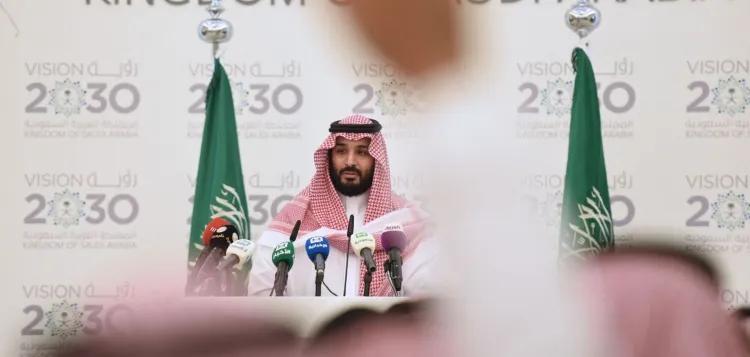Saudi Arabia's Non-Oil Sector Sees Rapid Growth Amid Vision 2030 Push

Saudi Arabia’s non-oil business sector experienced its fastest growth in over a decade in January 2025, as the Riyad Bank Saudi Arabia Purchasing Managers' Index (PMI) surged to 60.5 from 58.4 in December. This marked the highest level since September 2014, signaling a strong economic performance in the non-oil sector and reinforcing the nation’s ongoing diversification efforts under its Vision 2030 plan.
Strong Performance Driven by New Orders and Economic Conditions
The PMI’s rise above the critical 50-mark indicates growth in the non-oil economy, with the sharp increase in new orders serving as a key driver. The new orders index jumped to 71.1, the highest since June 2011. This surge reflects favorable economic conditions, robust domestic demand, and an increase in export sales. New infrastructure projects initiated by the government, particularly in sectors like construction and manufacturing, played a vital role in boosting economic activity across the kingdom.
The economic growth of the non-oil sector has become increasingly important as Saudi Arabia works to reduce its dependence on oil revenues and build a more diverse and sustainable economy. This expansion is a significant step toward the goals set by Saudi Arabia’s Vision 2030, which aims to diversify the economy and reduce reliance on hydrocarbons.
Strong Export Demand and Regional Growth
The growth of Saudi Arabia's non-oil sector was further supported by strong export demand, especially from countries in the Gulf Cooperation Council (GCC). As a member of the GCC, Saudi Arabia benefits from close regional trade ties, and the kingdom's comparative pricing strategies have bolstered its export activity. The positive regional trade environment reflects the wider economic growth in the GCC, and Saudi Arabia’s integration into regional trade networks has enhanced its export opportunities.
Government estimates have shown that non-oil growth surged to 4.6% in the fourth quarter of 2024, outperforming overall GDP growth. This underscores the pivotal role the non-oil sector plays in the kingdom's economic development as the government continues to emphasize economic diversification.
Employment Growth and Business Confidence
The rise in employment levels, a key indicator of business activity, has signaled the strength of the non-oil sector’s growth. This trend reflects robust hiring across various industries, driven by strong domestic demand and increasing export activity. The uptick in employment also points to a positive outlook for the job market as businesses continue to expand.
Despite facing rising input costs, companies remain optimistic about the future. The pressure on input prices led to the fastest increase in output prices in about a year. However, this has not dampened business sentiment. In fact, companies are increasingly confident in their ability to sustain growth, with expectations for future output improving to their highest level since March 2024. The confidence is driven by sustained demand, ongoing government support, and strategic expansion plans aimed at tapping into domestic opportunities and strengthening regional trade ties.
Vision 2030 and Economic Diversification
Saudi Arabia’s Vision 2030, spearheaded by Crown Prince Mohammed bin Salman, has set ambitious goals for transforming the kingdom’s economy. A central focus of this plan is to reduce the country’s dependence on oil and develop non-oil industries such as tourism, entertainment, technology, and manufacturing. The strong performance of the non-oil sector in recent months aligns with these objectives, demonstrating the effectiveness of the kingdom's economic diversification strategies.
The government's investment in infrastructure projects, coupled with efforts to improve the business environment, has created a favorable climate for economic growth. These efforts have attracted both local and international investors, boosting confidence in Saudi Arabia’s future economic prospects. As part of the Vision 2030 agenda, Saudi Arabia is also working to promote private sector growth and create new opportunities for both businesses and workers.
Challenges and the Path Forward
Despite the positive outlook, Saudi businesses continue to face challenges, including rising input costs, which have led to an increase in output prices. However, businesses are adapting by focusing on cost-efficient strategies and maintaining a keen eye on regional market dynamics. The government’s continued focus on infrastructure development and favorable economic policies is expected to help mitigate some of these challenges.
In terms of the broader regional and global economy, Saudi Arabia’s trade and economic growth will also depend on the stability of international markets and the ongoing shift toward renewable energy sources. As the country works to diversify its economy, these external factors will play an important role in shaping its future.
Conclusion
Saudi Arabia’s non-oil sector is showing remarkable resilience and growth as it navigates its ambitious diversification agenda. With a strong surge in new orders, rising employment, and positive business sentiment, the kingdom is on track to achieve its Vision 2030 goals. Continued government initiatives, coupled with strong regional trade and export demand, will be key to maintaining this momentum. As the non-oil sector thrives, Saudi Arabia is increasingly positioning itself as a major player in the global economic landscape, with a focus on sustainability, innovation, and growth beyond oil.
What's Your Reaction?














